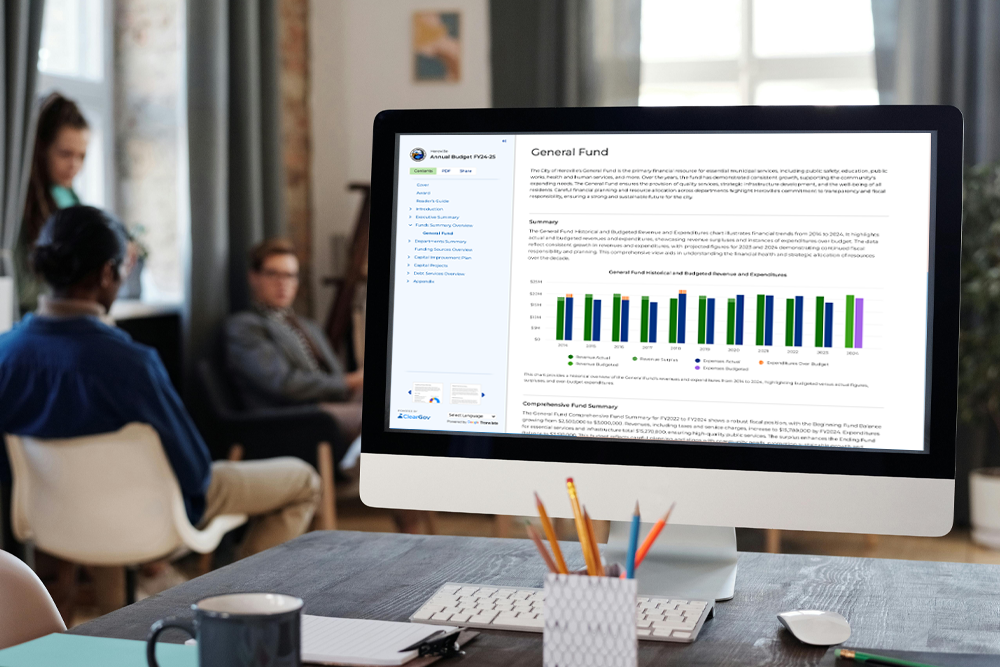Strategic planning is an important process for local governments looking to align priorities with resources to create a long-term vision for their communities. By engaging stakeholders, setting clear goals, and monitoring progress, local governments can drive positive results to better serve their communities.
However, it’s equally important to be aware of some common pitfalls that can hinder progress, such as taking a siloed approach or failing to be adaptable.
The 5 “Dos” Of Strategic Planning For Local Governments
1. Conduct Thorough Research And Analysis
Start the strategic planning process by gathering comprehensive data on your local government’s current situation, including demographics, economic trends, and the political landscape.
Best Practices:
- Diversify your data sources by using both internal records and external resources like census data, economic reports, and citizen surveys.
- Consider partnering with universities, think tanks, or research organizations for specialized expertise.
- Ensure you are working with the most accurate and up-to-date information available for sound decision-making.
2. Engage A Wide Range Of Stakeholders
Strategic planning should be an inclusive process, not a top-down mandate. Actively involve citizens, community organizations, local businesses, other government agencies, and internal staff from all levels and functions.
Best Practices:
- Use multiple channels to solicit feedback and encourage participation, such as town hall meetings, online surveys, focus groups, and advisory committees. Be proactive in reaching out to underrepresented groups.
- Provide opportunities for open-ended feedback from stakeholders and look for common themes that arise. Prioritize the goals and concerns that are most important to the community.
- Always maintain transparency around how stakeholder input is being used and how decisions are made to build public trust and buy-in. Communicate progress to stakeholders throughout the entire planning process.
3. Set Clear And Achievable Goals
Based on the research and stakeholder feedback, create a set of high-level strategic goals that are Specific, Measurable, Achievable, Relevant, and Time-bound (SMART).
Best Practices:
- Ensure the goals align with the community’s overarching long-term vision. Resist the temptation to be everything to everyone—limit the plan to a few focused goals.
- Be realistic about the resources available to you. An overly ambitious plan that ignores resource limitations (both human and financial) may struggle to succeed. Goals should challenge the organization but still be attainable.
- Involve key stakeholders, like the departments and employees who will be responsible for executing daily tasks, to ensure they’re realistic. Goals handed down from leadership may face resistance.
4. Develop Actionable Strategies
Once high-level goals are defined, create clear, detailed strategies and action plans for achieving them. Outline concrete steps, timelines, milestones, and performance metrics.
Best Practices:
- Once again, engage the departments and employees who will be responsible for executing the plan day-to-day. They often have valuable insights from the frontline and can share any potential challenges or opportunities they foresee.
- Use methods like a SWOT (Strengths, Weaknesses, Opportunities, Threats) analysis to spark creative solutions and think through your strategic choices.
- As with your goals, make sure strategies are realistic and achievable given the available resources and capabilities. Be willing to make hard choices and tradeoffs to focus efforts on your most important goals.
5. Monitor And Evaluate
Establish a system for regularly measuring, reporting, and reviewing progress on the implementation of your strategic plan. Define measurable key performance indicators (KPIs) that align to each goal and strategy.
Best Practices:
- Collect relevant data on an ongoing basis through your strategic planning software (have you checked out ClearPlans yet?), budget tracking, data analytics, and stakeholder feedback. Don’t wait until the end to see results!
- Create user-friendly dashboards, scorecards, or other reporting tools to see the status of key initiatives and results at a glance. Share these reports internally and externally for accountability and to keep the momentum going.
- Schedule regular performance reviews to honestly discuss what’s working well, what’s off track, and what adjustments are needed. Be open to modifying strategies and tactics based on results and changing circumstances. A strategic plan is a living document!
The 5 “Don’ts” Of Strategic Planning For Local Governments
1. Lack Of Alignment With Long-Term Vision
A strategic plan that is disconnected from the community’s long-term vision and goals, or that doesn’t consider long-term impacts and future needs, is unlikely to deliver lasting value.
Best Practices:
- Start with an objective assessment of the organization’s vision, mission, and values—what you ultimately want to accomplish and what principles guide you. The strategic plan should clearly link to these with the goal of bettering your community.
- Analyze the trends, challenges, and opportunities facing the community over a 5, 10, or 20+ year time range; don’t just consider immediate issues. How might the needs of your citizens, infrastructure, local economy, or political landscape evolve?
- Periodically review the strategic plan against your vision and long-term goals to ensure alignment and adjust the plan if needed. What made sense at one time may become obsolete as circumstances change.
2. Siloed Approach
When a small group or a single department is solely responsible for planning, the process is less inclusive, which can result in blindspots and misguided strategies. It also makes it harder to get buy-in for the plan. Remember, top-down mandated plans are often met with resistance from the employees responsible for the day-to-day tasks.
Best Practices:
- Assemble a strategic planning “steering committee” that includes representatives from multiple departments, levels, and functions. Involve external stakeholders, including citizens and researchers, as needed.
- Provide opportunities for cross-departmental collaboration. Bringing together staff from different areas to solve specific challenges helps break down silos and turf battles.
- Look for ways to align department goals to shared community priorities, and identify opportunities to combine efforts and resources to achieve them.
- Create formal processes that further break down silos, such as cross-functional teams or regular planning meetings. Build strategic collaboration into your normal way of working.
3. Lack Of Implementation Planning
Even the best strategic plan will have little impact without a crystal clear roadmap for implementation. A common pitfall is jumping from lofty goals straight back into business-as-usual without a strategy to drive change.
Best Practices:
- Create detailed implementation plans that break goals into concrete action plans, with clear timelines, milestones, resource requirements, and owners for each.
- Develop accountability strategies to keep implementation on track, such as regular status reports to leadership, project dashboards, and individual performance goals tied to the plan.
- Communicate roles and expectations clearly to everyone involved in executing the plan. Provide training and support for any new jobs or processes that need to be created.
- Treat strategic plan implementation as a change management process. Build buy-in with employees, celebrate short-term wins, and make the strategic goals part of your organization’s day-to-day routines and culture.
4. Failure To Adapt
Strategic plans often fail because of unexpected events and changing circumstances. Covid is a prime example of how quickly things can change for local governments. One of the biggest mistakes is to view the plan as a static document rather than a living strategy.
Best Practices:
- Embrace an agile mindset by building flexibility into your plan so you can adjust as needed. Focus on taking action and learning as you go, instead of trying to predict the future.
- Check your progress regularly, look at what’s changed, and decide if you need to modify your plan. Make changes as needed, but stay true to your overarching goals. Remember, your short-term strategies and action plans may change often, but the long-term vision for your community should remain mostly the same.
- Consider scenario planning to think about how your plan might need to change if different situations occur. Have backup plans ready for major risks or changes.
- Keep everyone informed. If you need to make major changes to your plan, let stakeholders know why and how it affects them.
5. Insufficient Capacity And Resources
Strategic plans will fail if you don’t allocate enough people, money, and technology resources to get the job done. If your goals don’t match your means, you’re setting yourself up for frustration.
Best Practices:
- Take an honest look at your current resources. Identify any major gaps in staffing, skills, funding, or infrastructure that could derail your strategic plan.
- Make sure your strategic plan and budget are closely aligned. Estimate costs for major initiatives and create a realistic budget to fund your plan in the coming years.
- Be clear with employees about what you expect, and give them the training, support, resources, and recognition they need to succeed with their new tasks.
- Think creatively about how to get the resources you need. Consider partnering with local organizations, sharing resources across departments, or tackling your plan in phases.
ClearPlans Takes The Guesswork Out Of Planning
ClearPlans takes the guesswork out of strategic planning and helps you create a plan that works for your community. Our strategic planning solution designed for the public sector provides a user-friendly platform for creating, executing, tracking, and communicating your strategic plan—all in one place.
With ClearPlans, you can:
- Build your plan using a flexible framework that incorporates proven best practices
- Assign tasks, set deadlines, and collaborate with stakeholders across departments
- Track progress with intuitive dashboards and customizable KPIs
- Allocate budgets and resources to ensure your plan is fully funded
- Publish your plan online to keep citizens informed and engaged
Whether you’re just getting started or looking to take your strategic planning to the next level, ClearPlans is the solution you’ve been looking for. Schedule a demo today and see how easy it can be to create a strategic plan that drives real results for your community.













